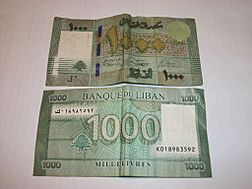Lebanese pound facts for kids
Quick facts for kids Lebanese pound |
|||
|---|---|---|---|
|
|||
| ISO 4217 Code | LBP | ||
| User(s) | |||
| Inflation | 177.25% | ||
| Source | https://economics.creditlibanais.com/Article/212047#en | ||
| Pegged with | U.S. dollar note |
||
| Subunit | |||
| 1⁄100 | piastre | ||
| Coins | LL 250, LL 500 | ||
| Banknotes | LL 1,000, LL 5,000, LL 10,000, LL 20,000, LL 50,000, LL 100,000 | ||
| note Dual exchange rate system (Sayrafa) in effect as of June 2021 | |||
The lira or pound is the money used in Lebanon. Its official name is līra Libnāniyya in Arabic and livre libanaise in French. You'll often see it shortened to LL or ل.ل..
Long ago, one lira was split into 100 piastres. But because of very high inflation during the Lebanese Civil War (1975–1990), piastres are no longer used. All of Lebanon's coins and banknotes have writing in both Arabic and French.
From 1997 to 2023, the official value was about LL 1,507.50 for one US dollar. However, after Lebanon's economic crisis in 2020, this rate was hard to get. A different, unofficial market appeared with much higher exchange rates. On February 1, 2023, the Central Bank changed the official rate to LL 15,000 per US dollar. By March 2023, the unofficial rate had dropped to LL 100,000 per dollar.
Contents
History of Lebanese Money
Until World War I, the Turkish pound was the money used in Lebanon. After the Ottoman Empire fell in 1918, the Egyptian pound was used.
When France took control of Syria and Lebanon, they introduced a new currency. This was the Syrian pound, which was linked to the French franc. In 1939, Lebanon's money officially became separate from Syria's. However, it was still connected to the French franc.
During World War II, when France was defeated, the Lebanese currency was linked to the British pound. After the war, it went back to being linked to the French franc. But this link was stopped in 1949.
Before the Lebanese Civil War, the Lebanese pound was worth much more. For example, in 1965, US$1 was worth LL 3.07. By 1981, it was about LL 4. In 1986, the pound started losing its value quickly. By 1992, one US dollar was worth over LL 2,500.
The government then tried to keep the currency's value stable. From 1997 to 2023, the official rate was set at LL 1,507.50 for one US dollar.
Recent Money Changes
In August 2019, the Lebanese pound started to lose value again. This created a separate market where the exchange rate was different from the official one. By March 2021, one US dollar was worth LL 10,000 in the free market. By July 2021, it was around LL 24,000. On March 18, 2023, the Lebanese pound hit its lowest value ever. It dropped to LL 111,000 against the US dollar in the free market.
In May 2021, Lebanon's Central Bank (BDL) started a new online system called "Sayrafa." This system was meant to record all money exchanges and show the exchange rates. It became the official rate for credit card payments in February 2022. However, by March 2023, the Sayrafa rate was much lower than the unofficial free market rate.
Lebanese Coins
Lebanon's first coins were made in 1924. They were for 2 and 5 piastres. Later, coins were made in different values, from half a piastre to 50 piastres and 1 lira. During World War II, some coins were made quickly and were not very fancy.
After the war, the way "qirsh" (piastre) was spelled in Arabic changed. New coins were made from 1952 to 1986. No coins were made between 1986 and 1994.
Today, only the 250-pound and 500-pound coins are commonly used. The other smaller coins are not worth much anymore because of the very high inflation.
| Coins of the Lebanese pound | ||||||||
|---|---|---|---|---|---|---|---|---|
| Image | Value | Technical parameters | Colour | Date of issue |
||||
| Obverse | Reverse | Diameter | Thickness | Mass | Metal | |||
| Coins no longer in circulation | ||||||||
 |
 |
5p | Aluminium-bronze | 1924 |
||||
 |
 |
5p | Aluminium-bronze | 1925 1931 1933 1936 1940 |
||||
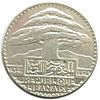 |
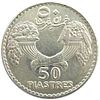 |
50p | 10 g | Silver | 1929 1933 1938 |
|||
 |
 |
5p | 18 mm | 2.2 g | Copper-nickel-aluminium | Golden yellow | 1968 1969 1972 1975 |
|
 |
 |
10p | 21 mm | 3.2 g | Copper-nickel-aluminium | Golden yellow | 1968 1969 1970 1972 1975 |
|
 |
 |
25p | 23.5 mm | 4 g | Nickel-brass | Golden yellow | 1968 1969 1970 1972 1975 1980 |
|
 |
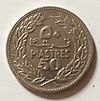 |
50p | 24 mm | 6 g | Nickel | White nickel | 1968 1969 1970 1971 1975 1978 1980 |
|
| LL 1 | 27.5 mm | 8 g | Nickel | White nickel | 1975 1977 1980 1981 |
|||
| 27 mm | 7.22 g | Nickel-plated steel | White nickel | 1986 | ||||
| Coins in circulation | ||||||||
| LL 25 | 20.5 mm | 1.3 mm | 2.8 g | Nickel-plated steel | White nickel | 2002 | ||
 |
 |
LL 50 | 19 mm | 1.15 mm | 2.25 g | Stainless steel | White nickel | 1996 |
| LL 50 | 21.5 mm | 1.67 mm | 3g | Nickel-plated steel | 2006 | |||
 |
 |
LL 100 | 22.5 mm | 1.80 mm | 4 g | Zinc and copper | Red copper | 1995 1996 2000 |
 |
 |
LL 100 | 22.5 mm | 1.83 mm | 4 g | Steel and nickel | White | 2003 |
| LL 100 | 22.5 mm | 1.80 mm 1.60 mm |
4 g | Steel and copper | Red copper | 2006 2009 |
||
 |
 |
LL 250 | 23.5 mm | 1.82 mm | 5 g | Copper and aluminium | Yellow gold | 1995 1996 2000 2003 |
| 1.65 mm | Nordic Gold | Nordic Gold | 2006 2009 2012 |
|||||
 |
 |
LL 500 | 24.5 mm | 2.05 mm | 6 g | Nickel-plated steel | White | 1995 1996 2000 2003 2006 2009 2012 |
| For table standards, see the coin specification table. | ||||||||
Lebanese Banknotes
Lebanon's first banknotes were printed in 1925. They ranged from 25 piastres to LL 100. In 1939, the bank's name changed. Between 1942 and 1950, the government printed "small change" notes. These were for 5, 10, 25, and 50 piastres.
After 1945, the bank kept printing money for Lebanon. But the notes were clearly marked as "Lebanese pounds" to tell them apart from Syrian money. Notes for LL 1, LL 5, LL 10, LL 25, LL 50, and LL 100 were made.
The Banque du Liban (Bank of Lebanon) was created in 1964. This bank was given the only right to print money. It issued notes for LL 1, LL 5, LL 10, LL 25, LL 50, LL 100, and LL 250. The front of the notes was in Arabic, and the back was in French. In the 1980s and 1990s, higher value notes were printed. This was because inflation made the old notes worth less.
Here are the banknotes used today:
| Circulating banknotes | |||||
|---|---|---|---|---|---|
| Image | Value | Dimensions | Main colour | Date of issue | |
| Obverse | Reverse | ||||
 |
 |
LL 1,000 | 156 × 67 mm | Teal | 1988 1990 1991 1992 |
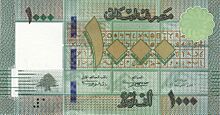 |
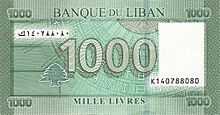 |
115 × 60 mm | 2011
2012 |
||
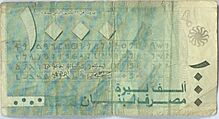 |
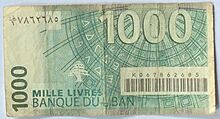 |
2004
2008 |
|||
| LL 5,000 | 156 × 67 mm | Pink | 1994 1995 |
||
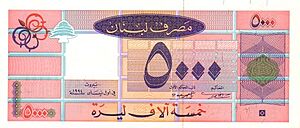 |
140 × 70 mm | 1999 2001 |
|||
| 120 × 62 mm | 2004 2008 |
||||
| 2012 | |||||
| LL 10,000 | 145 × 73 mm | Yellow | 1998 | ||
| 127 × 66 mm | 2004 2008 |
||||
| 2012 | |||||
 |
LL 20,000 | 150 × 80 mm | Red | 1994 1995 2001 |
|
| 130 × 72 mm | 2004 | ||||
| 2012 | |||||
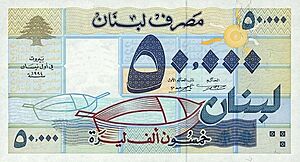 |
LL 50,000 | 150 × 80 mm | Blue | 1994 1995 1999 2001 |
|
| 140 × 77 mm | 2004 | ||||
| 2011 2012 |
|||||
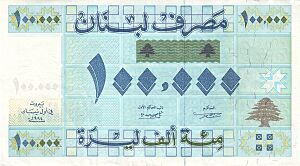 |
LL 100,000 | 161 × 90 mm | Green | 1994 1995 1999 2001 |
|
| 147 × 82 mm | 2004 | ||||
| 2011 2012 |
|||||
| 135 x 66mm | Green | 1 December 2023 | |||
| For table standards, see the banknote specification table. | |||||
All current banknotes have a French side and an Modern Standard Arabic side. The French side uses regular numbers. The Arabic side uses Eastern Arabic numbers.
Why Higher Value Banknotes Might Be Needed
The highest banknote is LL 100,000. This is currently worth only a little more than $1 US dollar. Because of this, there have been talks about printing new banknotes. These might be for LL 500,000 and even LL 1,000,000. This would make it easier to handle larger amounts of money.
Understanding Money Devaluation
On February 1, 2023, Lebanon officially lowered its exchange rate. This was the first time in 25 years. The value was cut by 90%. Even with this big change, the local money is still worth much less than its market value. People often say, "There is no value," to describe the huge price changes.
Since late 2019, Lebanon's money has had many different values against the US dollar. This is because of problems in the banking system. Here are some of the different rates:
- Official rate: LL 15,000 (as of February 2023). This rate was LL 1,507.50 from 1997 to 2023. But after the 2019 financial crisis, it was rarely used.
- Sayrafa rate: LL 86,400 (as of May 2023). This is the rate the Central Bank uses for international credit and debit card payments.
- "Lollar" rate: LL 15,000. This rate is for withdrawing US dollars from banks in Lebanese pounds.
- Parallel market rate: LL 89,601.44 (as of May 2024). This is also called the black market rate. It is much higher than the official rate.
The parallel market rate is much higher than the official rate. The Lebanese pound's value stopped dropping because many things are now paid for in US dollars.
What is a "Lollar"?
A "lollar" is a special kind of US dollar deposit in Lebanese banks. It's like money that is stuck or frozen in the bank. You can only take it out in Lebanese pounds at a very low, set rate. This rate is much lower than the unofficial market rate. There are also limits on how much you can take out.
The term "lollar" was created because Lebanese banks had big problems. They limited how much US dollars and other foreign money people could take out.
Why Lebanon's Economy Faced Problems
Lebanon's money problems became very clear in October 2019. Many people protested in the streets. But the economic situation had been getting worse for several years.
The Central Bank put strict limits on taking money out of foreign currency accounts. This was because they had trouble keeping the lira's value stable. This affected about 75% of all bank deposits. The main reason for the crisis was these strict controls on money movement.
The crisis had many effects on Lebanon and its people. They faced challenges like:
- New official rates for different types of payments.
- Very high inflation (hyperinflation).
- A big drop in the country's economic output (GDP).
- Businesses closing down and more people losing their jobs.
Lebanon also faced the COVID-19 pandemic. Then, a huge explosion happened in Beirut on August 4, 2020. This terrible event caused many deaths and injuries. It also destroyed a large part of the capital city.
Many people think that using the US dollar as the official money could help fix the current severe crisis.
See also
 In Spanish: Libra libanesa para niños
In Spanish: Libra libanesa para niños
- Economy of Lebanon
- Syrian pound
| Current LBP exchange rates | |
|---|---|
| From Google Finance: | AUD CAD CHF EUR GBP HKD JPY USD JPY USD |
| From Yahoo! Finance: | AUD CAD CHF EUR GBP HKD JPY USD JPY USD |
| From XE.com: | AUD CAD CHF EUR GBP HKD JPY USD JPY USD |
| From OANDA: | AUD CAD CHF EUR GBP HKD JPY USD JPY USD |
| From fxtop.com: | AUD CAD CHF EUR GBP HKD JPY USD JPY USD |


